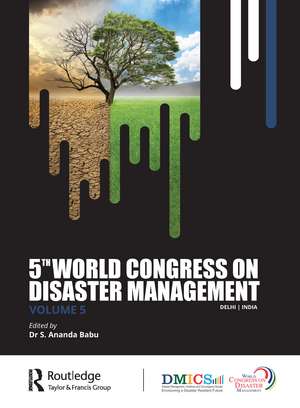5th World Congress on Disaster Management: Volume V: Fifth World Congress on Disaster Management
Editat de S. Ananda Babuen Limba Engleză Hardback – 27 apr 2023
| Toate formatele și edițiile | Preț | Express |
|---|---|---|
| Hardback (2) | 835.40 lei 6-8 săpt. | |
| Taylor & Francis – 27 apr 2023 | 835.40 lei 6-8 săpt. | |
| Taylor & Francis – 16 feb 2023 | 836.63 lei 6-8 săpt. |
Preț: 835.40 lei
Preț vechi: 1224.90 lei
-32% Nou
Puncte Express: 1253
Preț estimativ în valută:
159.85€ • 166.90$ • 132.30£
159.85€ • 166.90$ • 132.30£
Carte tipărită la comandă
Livrare economică 04-18 aprilie
Preluare comenzi: 021 569.72.76
Specificații
ISBN-13: 9781032355528
ISBN-10: 1032355522
Pagini: 576
Ilustrații: 100 Illustrations, black and white
Dimensiuni: 210 x 280 mm
Greutate: 1.32 kg
Ediția:1
Editura: Taylor & Francis
Colecția Routledge
Seria Fifth World Congress on Disaster Management
Locul publicării:Oxford, United Kingdom
ISBN-10: 1032355522
Pagini: 576
Ilustrații: 100 Illustrations, black and white
Dimensiuni: 210 x 280 mm
Greutate: 1.32 kg
Ediția:1
Editura: Taylor & Francis
Colecția Routledge
Seria Fifth World Congress on Disaster Management
Locul publicării:Oxford, United Kingdom
Public țintă
General, Postgraduate, and Professional ReferenceCuprins
Part 1: Challenges and Opportunities of Green Infrastructure 1. Challenges and Opportunities of Green Infrastructure in Urban India 2. Harnessing Geospatial Data to Design Blue-green Infrastructure for Building Regional and Local Scale Disaster Resilience 3. Green Infrastructure for Flood Risk Reduction: An Ecological Planning Framework 4. Landscape Based Mitigation Proposals for Risk Resilience in Cyclone Hit Area of Pudimadaka, Vishakhapatnam 5. Developing System Dynamics Model for Flood Risk Management Through Green Infrastructure 6. Landscape Based Mitigation Proposals for Risk Resilience in Flood Prone Area of Munroe Island, Kollam, Kerala 7. The Importance of Re-Engineering Geo-Energy Exploitation toward the Green Energy Economy: A Critical Assessment 8. Cyclone Risk Resilience and Disaster Management at the Mouth of Devi River, Orissa—A Landscape Design Based Approach Part 2: Environmental Issues in Disaster Risk Management 9. A Downward Spiral? Deconstructing Livelihood Diversification and Sustainability in Sundarbans Delta Region, India 10. Empirical Study of Air Quality w.r.t. RSPM in Air Quality Stations of India using Data Analytics 11. Detection of Shoreline Changes in the Highly Vulnerable Coastal Watersheds of Tamil Nadu Using DSAS 12. Techno-Social Approach to Ecological Risk Reduction and Resilience Building Learning from Tribes of Jharkhand 13. Degradation of Mangroves along Coastline of Andhra Pradesh and Strategies for Conservation 14. Epistemology of Coastal Sand Dune Landscape and Disaster 15. Rejuvenation for the Earth 16. Massive River Projects: Impact on Human and Aquatic Life (With Special Reference to River Ganges, Varanasi) Part 3: Emerging Challenges for Urban Planning 17. Strategies for Integrating Health and Urban Planning 18. Pursuing Resilience and Inclusive Approach in Planning: The Urban Aspect of COVID-19 19. COVID-19 and Resilient City: Lessons from the Pandemic 20. An Impact Assessment Framework of Urban Physical Characteristics to Mitigate Urban Heat Island Effects 21. Mitigation of Planning Void by Flyovers through Intersection Area Land Use planning 22. Disaster Risk Reduction Policies for Public Heritage Building 23. Urban Regeneration of Cultural Core for Building Resilience: Case Study of Nashik Part 4: Making Cities Resilient: Case Studies 24. Integrated Urban Water Management in Chandigarh Smart City 25. GAPS and Challenges DRR Initiatives, Navi Mumbai 26. Household Level Disaster Risk Knowledge in Urban Slums and Rich Community, Dhaka 27. Impact of Development on Natural Drainage—A Case of Chennai 28. Urban Sprawl and Climate Change Resilience in Kolkata Metropolitan Area, India 29. Building Resilient Smart Cities: Sustainability and Inclusiveness Part 5: Issues of Health Risk Management 30. Health Strategy During Disaster: An Economic and Pharmaconomic Approach 31. Integrating Dentists as Human Resource in Disaster Management 32. Integration of Disaster Management with Public Health: A Capacity-Building Approach Part 6: Managing Risks of Agricultural Sector 33. A Comprehensive Technique to Agricultural Risk Management for Enhancing Resilience 34. Contribution of Bamboo Cultivation for Disaster Risk Reduction & Livelihood in Coastal Areas of Bangladesh 35. National Flood Insurance for Sustainable Aquaculture: The Case of Minna, Nigeria 36. Disaster Risk Assessment of Horticulture Farming Community for Developing Sustainable Human Settlement 37. Toxic Industrial Chemicals: An Emerging Disaster Threat 38. “Risk Transfer as a Strategy for Disaster Risk Reduction: A Critical Evaluation of Prime Ministers Crop Insurance Scheme in Karnataka” Part 7: Hazard, Vulnerability and Risk Assessment: Case Studies 39. Effect of Natural Disasters in North Eastern Region of India—A Review 40. Disaster Vulnerability Assessment: A Case Study of Puducherry 41. Multi-Hazard Risk Assessment of Schools in Lower Himalayas: Haridwar District, Uttarakhand, India 42. Mainstreaming Risk Reduction in Planning Practices for Vulnerable Hill Settlement: A Case of Uttarakhand 43. Multi-Hazard Risk Vulnerability Assessment, Case of Dehradun, Uttarakhand, India Part 8: Assessing and Mitigating Risks of Landslides 44. Slope Management for Himalayan Landslides 45. Climate Change Impacts on Ecosystem and Himalayan Landslides 46. Role of Liquefaction for Seismogenic Landslides in Road Network of Himalyan Terrain of India 47. A Comparison Between Automated Tool (SMR Tool) and Graphical Approach for mode of Failure and Calculation of Slope Mass Rating Index (SMR) 48. Slope Failure and Stabilization of Slope in Transportation Systems in Hilly Areas 49. Causes and Mitigation for Risk Resilience in Landslide Prone Area-Kasol, Himachal Pradesh
Notă biografică
S. Ananda Babu is President of DMICS and Convenor of WCDM
Descriere
The fifth WCDM deliberates on three critical issues that pose the most serious challenges as well as hold the best possible promise of building resilience to disasters. These are Technology, Finance, and Capacity.

